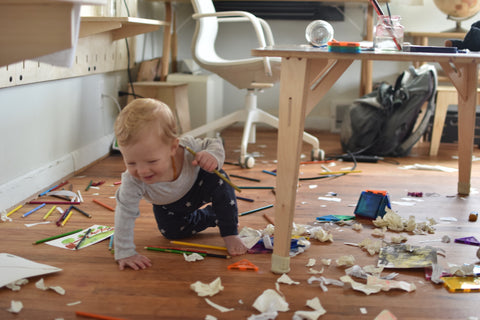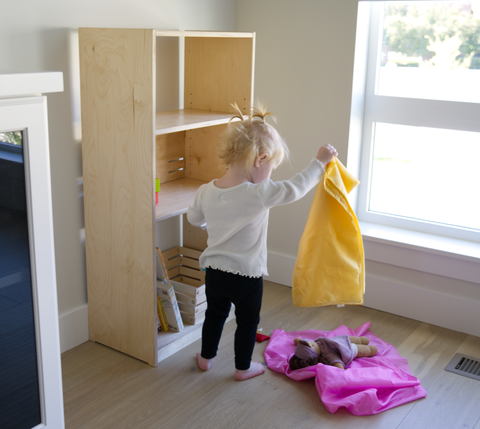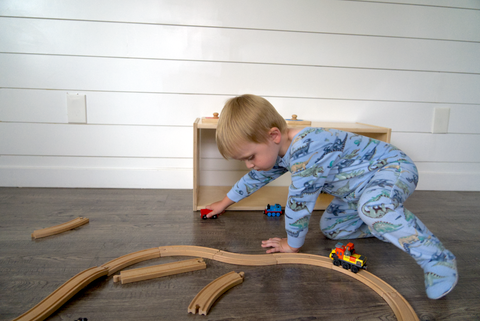Picture this: after spending what feels like hours meticulously organizing your child's toy shelves, you step out of the room for a moment only to return to a scene straight out of a tornado aftermath. Toys that were neatly arranged are now strewn across the floor, a chaotic mess that seems to mock your efforts. As you resist the urge to sigh in frustration, you can't help but wonder if your child has a secret mission to turn the house into a toy graveyard.
Why do children love making messes?
At first glance, it may seem like chaos when children are learning, especially when it involves what appears to be nothing more than making a mess. However, there's significant developmental progress happening beneath the surface.
For toddlers, dumping toys is not just a random act—it's a fundamental aspect of their growth. It serves several purposes:
-
Learning Cause-and-Effect: Children grasp the concept of cause-and-effect through actions like dumping toys.
-
Enhancing Sensory and Motor Skills: The physical act of dumping and exploring toys aids in sensory and motor development.
-
Asserting Control: Dumping toys allows children to exert control over their environment, a crucial aspect of their burgeoning independence.
-
Seeking Attention: Sometimes, dumping toys is a way for children to garner attention or engage with caregivers.
-
Expressing Emotions: It can also be a means for children to express emotions such as frustration or excitement.
-
Imitating Behavior: Children often mimic actions they observe, including dumping toys, as they try to make sense of the world around them.
If your child is in the dumping stage, here are a few ideas to try to set you and your child up for success:
Set clear expectations: Establish consistent behavior expectations and communicate them clearly. Instead of saying, "Don't dump the toys," you can try to frame your instructions positively. For example, "Let's keep our toys on the shelf and play with them gently."
How to encourage clean up: When your child dumps a basket, invite them to put toys back by category: cars with cars, blocks with blocks, animals with animals. It satisfies their urge to dump, builds organization skills, and makes cleanup feel like an activity instead of a chore.
Positive reinforcement: Acknowledge desired behavior with something like, "You put the blocks back where they belong. That shows respect for our materials. Thank you for taking care of our toys."
Ensure everything has a spot: The principle of "everything having a place and everything being in its place" is rooted in the idea of organization and orderliness. When toys and materials are organized neatly on low shelves like the Cube Shelf, Toy Organizer, or Luce Shelf, a child can independently access toys but also can put them away afterwards.
Rotate toys: When children are presented with too many toys at once, it can overwhelm them and lead to scattered play behavior, including dumping toys out aimlessly. Limiting options helps focus their attention and encourages more intentional play. Keep toys out of rotation out of sight with a shelf like this Toy Rotation Shelf.
Limiting the scope: On top of limiting options, consider the material you're making available and if it is something that can be built on. For instance, if there is an activity that comes with 30 pieces, you can only put five pieces out at first. When they master those five pieces and clean that work up, you can add more pieces to it.
Practice patience: Take deep breaths and remind yourself that toddler behavior is part of their development. Remember to be patient with yourself and your child as you navigate this stage together.
Have realistic expectations: It is a lot to expect a small child to be able to clean up every item from every mess, especially when they are in this stage. You might say, "Would you like me to help you, or do you want to tidy up by yourself?" Even when doing this very consistently, it still takes time for the younger ones to learn.
It can help to offer more controlled options to dump things. Offering an alternative activity where it can be replicated allows them to pursue their desire in a controlled environment. Consider these alternative dumping options to minimize mess and facilitate controlled exploration:
- Sensory Bins
- Water Play
- Outdoor Activities
- Building Blocks
- Recycling Activities
- Cooking and Baking
- Sorting and Transferring Games
While it can be challenging, your patience and guidance are invaluable in supporting your child's growth and development. Before you rush to tidy up the latest mess your child has made, take a moment to ponder: how can we embrace the mess as a pathway to discovery and growth, rather than a nuisance to be swiftly cleaned away?








